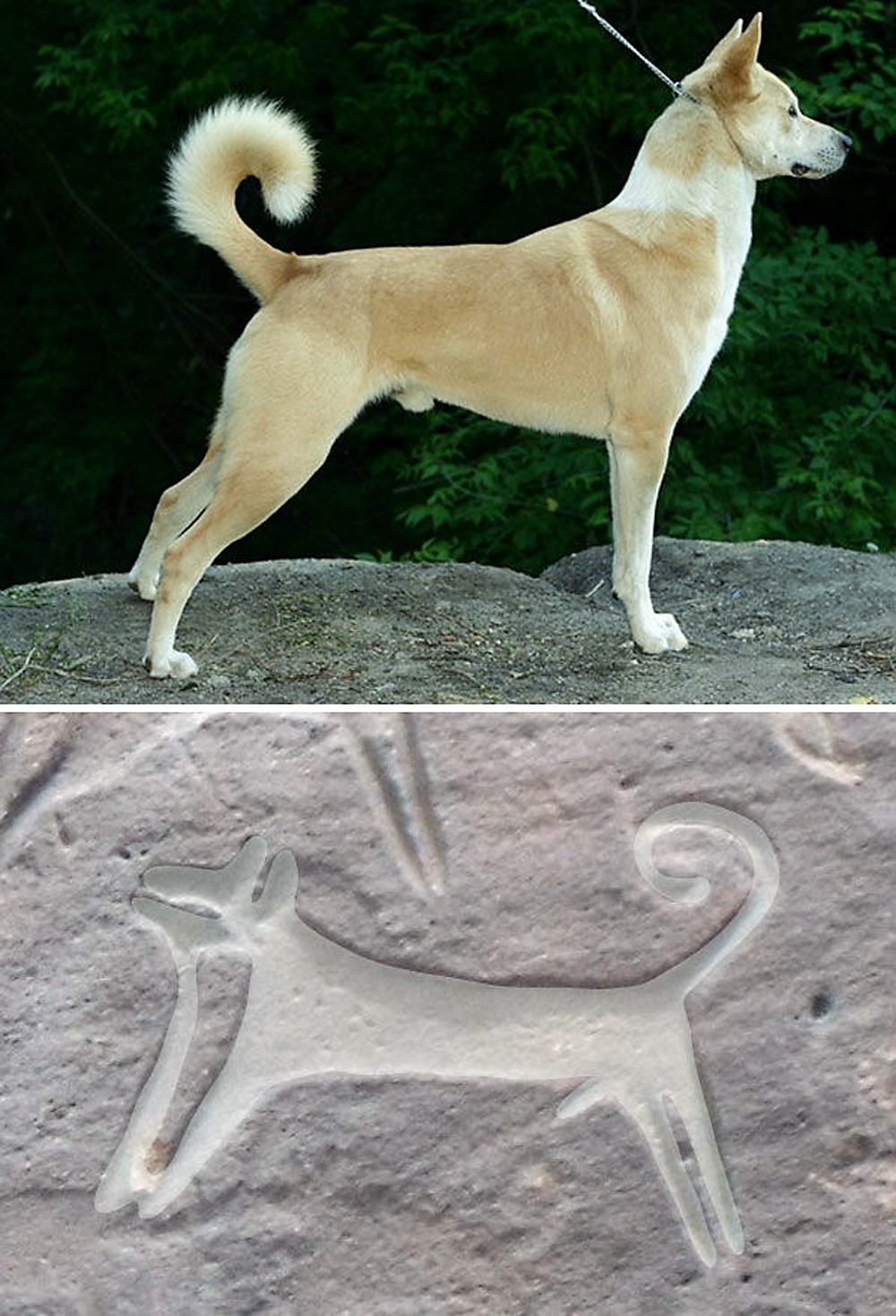


An article on sciencemag.org by David Grimm - These may be the world's first images of dogs - and they're wearing leashes - reports on the rock art engravings depicting hunting scenes in Saudi Arabia that may date back more than 8,000 years, making them the earliest depictions of dogs.
The engravings appear to depict leashes, suggesting that humans mastered the art of training and controlling dogs thousands of years earlier than previously thought.
Melinda Zeder, an archaeozoologist at the Smithsonian Institution National Museum of Natural History in Washington, D.C. states that it's the only real demonstration we have of humans using early dogs to hunt. She adds that more work will be needed to confirm both the age and meaning of the depictions.
First rock art images of hunting with dogs in #SaudiArabia https://t.co/lLrxOs1SO6 #petroglyphs #archaeology pic.twitter.com/GkpKRlMPe8
— Bradshaw Foundation (@BradshawFND) November 18, 2017
The hunting scene comes from Shuwaymis, a hilly region of northwestern Saudi Arabia where seasonal rains once formed rivers and supported pockets of dense vegetation. For the past 3 years, Maria Guagnin, an archaeologist at the Max Planck Institute for the Science of Human History in Jena, Germany, in partnership with the Saudi Commission for Tourism & National Heritage, has helped catalog more than 1,400 rock art panels containing nearly 7,000 animals and humans at Shuwaymis and Jubbah, a more open vista about 200 kilometers north that was once dotted with lakes.

Petroglyphs of the hunting dogs of Saudi Arabia may have resembled the Canaan breed of dog. Images: M.Guagnin et al., Journal of Anthropological Archaeology, 2017 & Alexandra Baranova.
Roughly 10,000 years ago, hunter-gatherers entered - or perhaps returned to - the region. Researchers believe the oldest rock art images depict women. From roughly 7,000 to 8,000 years ago, people in this region became herders, based on livestock bones found at Jubbah. Depictions of cattle, sheep, and goats began to dominate the rock art. The hunting dogs were carved between these two phases.
There are 156 at Shuwaymis and 193 at Jubbah. All are medium-sized, with pricked up ears, short snouts, and curled tails - hallmarks of domestic canines. In some scenes, the dogs face off against wild donkeys. In others, they bite the necks and bellies of ibexes and gazelles. And in many, they are tethered to a human armed with a bow and arrow.
The researchers can not directly date the images, but based on the sequence of carving, the weathering of the rock, and the timing of the switch to pastoralism, Guagin states that the canine rock art is at least 8000 to 9000 years old, and earlier than depictions of dogs painted on Iranian pottery dated to 8000 years ago, previously labelled the oldest.
The carved dogs resemble today's Canaan dog, a largely feral breed that roams the deserts of the Middle East. Reported recently in the Journal of Anthropological Archaeology, the team believes that could indicate these ancient people bred dogs that had already adapted to hunting in the desert. Alternatively, people may even have independently domesticated these dogs from the Arabian wolf long after dogs were domesticated elsewhere, which likely happened sometime between 15,000 and 30,000 years ago.
Paul Taçon, an archaeologist at Griffith University in Gold Coast, Australia, agrees that the chronology appears to be sound, but cautions that the lines in the engravings could be symbolic, perhaps a depiction of a bond. But either way, that bond was clearly strong, as the artists appear to have depicted dogs they actually knew, with particular coat patterns, stances, and genders.
Such a relationship would have been critical to helping people survive a harsh environment. Details of the images also suggest that the ancient hunters tailored their strategies to the landscape; at Shuwaymis, where the dogs may have been used to drive prey into the corners of uneven terrain, the art depicts large packs. At Jubbah, the images show smaller groups of dogs that may have ambushed prey at watering holes. People were able to venture into these inhospitable areas by strategically marshalling dogs to survive.
See more in the Rock Art of Saudi Arabia:
http://www.bradshawfoundation.com/middle_east/saudi_arabia_rock_art/index.php
To read this article in full:
http://www.sciencemag.org/news/2017/11/these-may-be-world-s-first-images-dogs-and-they-re-wearing-leashes
by Bradshaw Foundation
Wednesday 20 March 2024
by Bradshaw Foundation
Tuesday 13 February 2024
by Bradshaw Foundation
Tuesday 13 February 2024
by Bradshaw Foundation
Thursday 01 February 2024
by Bradshaw Foundation
Tuesday 28 November 2023
by Bradshaw Foundation
Thursday 23 November 2023
by Bradshaw Foundation
Monday 20 November 2023
by Bradshaw Foundation
Tuesday 31 October 2023
by Bradshaw Foundation
Thursday 26 October 2023
by Bradshaw Foundation
Wednesday 20 September 2023
by Bradshaw Foundation
Monday 17 July 2023
by Bradshaw Foundation
Sunday 09 July 2023
by Bradshaw Foundation
Tuesday 27 June 2023
by Bradshaw Foundation
Monday 26 June 2023
by Bradshaw Foundation
Thursday 27 April 2023
by Bradshaw Foundation
Friday 17 March 2023
by Bradshaw Foundation
Wednesday 20 March 2024
by Bradshaw Foundation
Tuesday 13 February 2024
by Bradshaw Foundation
Tuesday 13 February 2024
by Bradshaw Foundation
Thursday 01 February 2024
by Bradshaw Foundation
Tuesday 28 November 2023
by Bradshaw Foundation
Thursday 23 November 2023
by Bradshaw Foundation
Monday 20 November 2023
by Bradshaw Foundation
Tuesday 31 October 2023
by Bradshaw Foundation
Thursday 26 October 2023
by Bradshaw Foundation
Wednesday 20 September 2023
by Bradshaw Foundation
Monday 17 July 2023
by Bradshaw Foundation
Sunday 09 July 2023
by Bradshaw Foundation
Tuesday 27 June 2023
by Bradshaw Foundation
Monday 26 June 2023
by Bradshaw Foundation
Thursday 27 April 2023
by Bradshaw Foundation
Friday 17 March 2023
Friend of the Foundation











